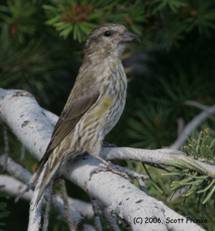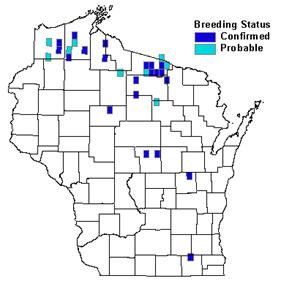Photo by Scott Franke


Status/Protection
- Global Rank: G5 Key to global and state ranks
- State Rank: SAB, SZN
- WBCI Priority: SGCN
Population Information
The Federal BBS information can be obtained at http://www.mbr-pwrc.usgs.gov/bbs/bbs.html by clicking on Trend Estimates and selecting the species in question. All estimates are for time period (1966-2005).
*Note: There are important deficiencies with these data. These results may be compromised by small sample size, low relative abundance on survey route, imprecise trends, and/or missing data. Caution should be used when evaluating this trend.
- Federal Breeding Bird Survey: non-significant decline
- Federal Breeding Bird Survey (WI): non-significant increase*
- Federal Breeding Bird Survey (BCR 23): N/A
- Federal Breeding Bird Survey (BCR 12): non-significant increase*
- WSO Checklist: declining (1983-2007)
Life History
- Breeding Range: Southern Alaska east across southern Canada and the northeastern U.S., extending south into mountainous regions of the U.S., Mexico, and Central America (Adkisson 1996).
- Breeding Habitat: White Pine, Red Pine, Black Spruce, Swamp Conifer-Balsam Fir, Pine Barrens, conifer forests with abundant cone crop.
- Nest: Bulky cup nest, typically 2-20 meters above ground (Ehrlich et al.1988, Adkisson 1996).
- Nesting Dates: Eggs: early April to early June (Robbins 1991).
- Foraging: Foliage glean (Ehrlich et al. 1988).
- Migrant Status: Short-distance migrant, irruptive.
- Habitat use during Migration: Pine and other conifer forests with abundant cone crop.
- Arrival Dates: Irregular and nomadic.
- Departure Dates: Irregular and nomadic.
- Winter Range: Boreal forest zone of southern Canada and the northern United States; montane areas of the western United States (Adkisson 1996).
- Winter Habitat: Stands of mature pine and other conifer forests (Adkisson 1996).
Habitat Selection
In Wisconsin Red Crossbills occur in mature conifer forests harboring large cone crops. Wisconsin Breeding Bird Atlas results documented Red Crossbills breeding in pine-dominated, upland conifer forests, lowland conifer forests, and conifer shrub habitats (Baughman 2006). Holimon et al. (1998) suggested that Red Crossbills preferentially select mature conifer stands over young stands for foraging. Mature stands typically produce larger cone crops, which helps to maximize the foraging efficiency of this species.
Habitat Availability
It is difficult to ascertain habitat availability for an irruptive species such as the Red Crossbill. This species can occur anywhere a suitable cone crop exists, which is unpredictable from year to year. Additionally, estimates of conifer forest cover invariably do not include tree age or seed bearing capacity. Thus, suitable habitat for Red Crossbill appears widespread in northern Wisconsin, but suitability is correlated more to cone production than acreage.
Population Concerns
Breeding Bird Survey data suggest a non-significant decline range-wide and a non-significant increase in Wisconsin (Sauer et al. 2005). However, the Red Crossbill’s erratic and nomadic movements preclude accurate population estimates. Its nomadic nature also makes confirming breeding difficult. During the six-year period (1995-2000) of the Wisconsin Breeding Bird Atlas, observers confirmed breeding in approximately 2% of the surveyed quads (Baughman 2006).
The Red Crossbill shows considerable morphological and vocal variation and has recently been classified into eight discrete types of flight calls north of the Mexican border. These call types appear to represent reproductively isolated populations and may be discrete species (Adkisson 1996). Little information is available regarding threats unique to these different populations or call types. However, the logging of mature habitats may depress some populations since conifers typically produce their largest cone crops after about 60 years of age (Benkman 1993).
Recommended Management
Management efforts for this species should focus on conserving conifer-dominated systems with a full range of age classes (WDNR 2005). Increasing harvest rotation times is one possible method to maintain the mature stands preferred by this species (Adkisson 1996). Improved natural regeneration methods and use of fire in pine management also may benefit Red Crossbills (WDNR 2005). Conservation and management strategies for this species should be focused in the following Wisconsin ecological landscapes: Central Sand Plains, North Central Forest, Northeast Sands, Northern Highland, Northwest Lowlands, Northwest Sands, and Superior Coastal Plain (WDNR 2005).
Research Needs
More research is needed concerning Red Crossbill genetics. Studies investigating the impacts of forest fragmentation on Red Crossbills also are warranted. For instance, what is the minimum patch size requirement to support breeding (Adkisson 1996)? Food profitability based on conifer seed energy content and ripening phenology remains poorly understood (WDNR 2005).
Information Sources
- Chequamegon National Forest Bird Survey (NRRI) species account: http://www.nrri.umn.edu/mnbirds/accounts/RECRa2.htm
- Nicolet Northern Forest Bird survey map: http://www.uwgb.edu/birds/nnf/species/RECR.htm
- North American Breeding Bird Survey: http://www.npwrc.usgs.gov
- Temple S.A., J.R. Cary, and R. Rolley. 1997. Wisconsin Birds: A Seasonal and Geographical Guide. Wisconsin Society of Ornithology and Wisconsin Department of Natural Resources, Madison, WI.
- Wisconsin Breeding Bird Atlas: http://www.uwgb.edu/birds/wbba/
References
- Adkisson, C.S. 1996. Red Crossbill (Loxia curvirosta). In The Birds of North America, No.256 (A. Poole and F. Gill, eds). The Academy of Natural Sciences, Philadelphia, and The American Ornithologists’ Union Washington, D.C.
- Baughman, J. 2006. Red Crossbill. In Atlas of the Breeding Birds of Wisconsin. (N.J. Cutright, B.R. Harriman, and R.W. Howe, eds.) The Wisconsin Society for Ornithology, Inc. 602pp.
- Benkman, C.W. 1993. Logging, conifers, and the conservation of crossbills. Conservation Biology 7: 473–479.
- Ehrlich, P.R., D.S. Dobkin, and D. Wheye. 1988. The Birders Handbook: A Field Guide to the Natural History of North American Birds. Simon and Schuster, Fireside. New York.
- Holimon, W.C., C.W. Benkman, and M.F. Willson. 1998. The importance of mature conifers to Red Crossbills in southeast Alaska. Forest Ecology and Management 102:167-172.
- Robbins, S.D. 1991. Wisconsin birdlife: population & distribution, past & present. Univ. of Wisconsin Press, Madison, WI.
- Sauer, J.R., J.E. Hines, and J. Fallon. 2005. The North American Breeding Bird Survey, Results and Analysis 1966 - 2005. Version 6.2.2006. USGS Patuxent Wildlife ResearchCenter, Laurel, MD.
- Wisconsin Department of Natural Resources (WDNR). 2005. Wisconsin’s Strategy for Wildlife Species of Greatest Conservation Need. Madison, WI.
Contact:
- Compiler: Ken Damro, kendamro@yahoo.com
- Editor: Kim Kreitinger, K.Kreitinger@gmail.com | Jim Baughman, James.Baughman@Wisconsin.gov
